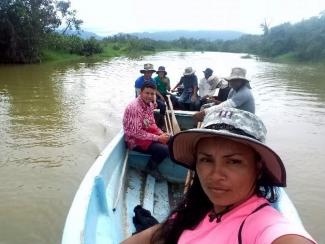Pabla leads initiatives for the conservation of the mangrove ecosystem and the development of community-based tourism.
On the northern Caribbean coast of Honduras, Pabla Rivera Vargas promotes community organizations, mangrove reforestation campaigns and solid waste management in her native Barra del Motagua, a coastal community in Omoa, Cortés, where the internationally recognized Cuyamel-Omoa Wetlands System is located.
At 32 years old, this single mother of three is a leader in her community, delivering the message, mainly to youth, of the importance of mangrove restoration to protect the community from the impact of storms and hurricanes, for the recovery of fishing, and the opportunity to fulfill their dreams at home.
As a participant in the USAID and the International Union for Conservation of Nature (IUCN)’s Regional Coastal Biodiversity Project, Pabla has developed her leadership as head of the coordination of the Barra del Motagua Multiple Services Company, made up mostly of young people committed to mangrove conservation. With the support of the project, a group of 14 people are implementing a landscape management initiative to promote the protection, conservation, and recovery of the mangrove ecosystem. In this way, they have established a red and black mangrove nursery and have planted 2,500 plants, with the expectation of planting more than 3,500 to recover one hectare of mangrove.
Pabla also leads mangrove plant geo-referencing processes, beach and mangrove cleaning campaigns in areas that provide important spaces for community tourism. She also supports biological monitoring of species, such as the yellow-headed parrot, which is endangered according to the IUCN Red List.
“I started this work at the end of 2011, and I have focused more on motivating the youth, on giving them a commitment to the community so they don't leave. We live in a beautiful place, and I have done well, because my children love to reforest, because they see what I do, and the young people in my group have stayed here,” says Pabla.USAID’s Regional Coastal Biodiversity Project with IUCN reduces threats to biodiversity in bordering coastal marine communities in Honduras, Guatemala, and El Salvador by working towards climate-smart solutions for prosperous local livelihoods and the conservation of coastal marine biodiversity.

